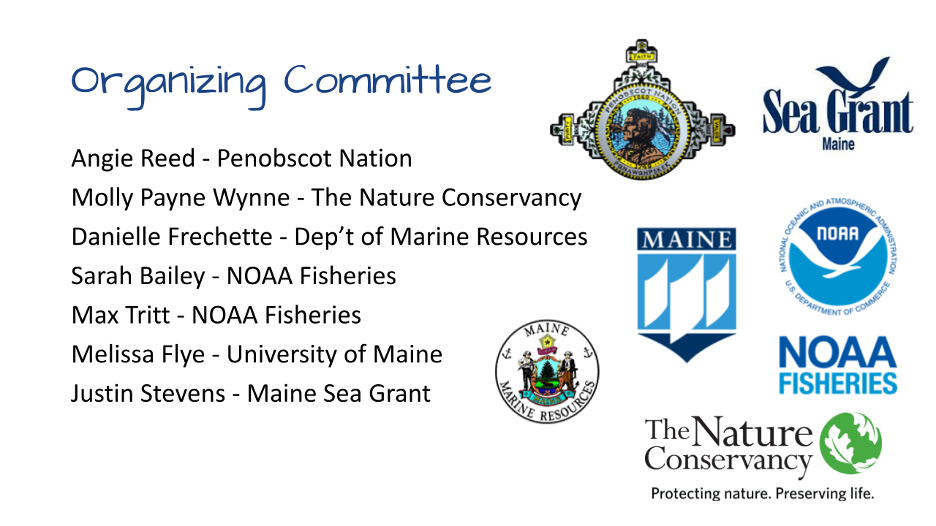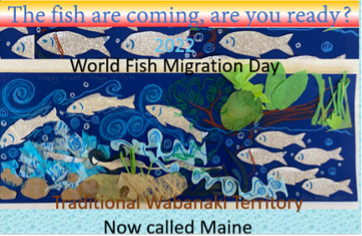Telling Our Story to Rebuild Sustainable Sea-run Fish Populations in Maine
We love sea-run fish, so how do we effectively talk about them?
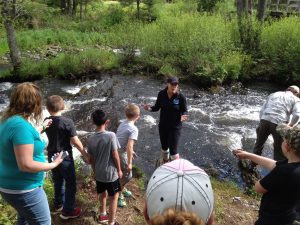
Communication, outreach, and community engagement are essential for restoring sea-run fish populations in Maine. However, on-the-ground practitioners, researchers, and fisheries managers rarely have formal training in communications. In 2021, with support from the Senator George J. Mitchell Center for Sustainability Solutions, we brought together our friends from across the sea-run fish community for a virtual workshop series where we learned to better tell our stories of sea-run fish restoration.
Supported by an organizing committee of individuals from:
- Maine Department of Marine Resources
- Maine Sea Grant
- NOAA Fisheries
- Penobscot Indian Nation
- The Nature Conservancy
- University of Maine
The workshop provided training in communications and human behavior to help us more effectively communicate about sea-run fish projects. The series was very successful and has inspired collaborative energy within the community.
The overall goals of the workshop were to:
- focus key messaging around sea-run fish restoration
- ensure inclusion of under-represented voices and perspectives
- identify key audiences
- inspire action in support of rebuilding sea-run fish populations

The following information and links on this website outline key elements, resources, and outcomes of this workshop series and aim to inspire continued collaborations and conversations about this essential work.
Pre-Workshop Session : Idea Generation
3 hours, March 9, 2021
As part of designing a collaborative and relevant workshop, we convened a working group of key representatives from more than 20 different organizations, including the Wabanaki Nations, state and federal agencies, local universities, and NGOs, for a half-day working session facilitated by Sea Grant.
Session objective: Bring together leaders from across the sea-run fish community to identify common themes in communications, using a participatory process
Session outcomes: A consolidated list of topics of greatest interest that became the focus of communication training and outreach messaging developed in later stages of the workshop series
Session 1: Communications training
3 hours, May 20, 2021 (Agenda & Worksheets available upon request)
This session was a half-day virtual workshop led by communications expert Brooke Tully that introduced sea-run fish practitioners to foundational elements of effective behavior change communications and strategies to motivate change.
Session objective: Learn behavioral insights and communication strategies that motivate people to take action for sea-run fish
Session outcomes: In this session, the participants:
-
-
- Clarified desired behaviors and actions related to restoring sea-run fish
- Identified audiences
- Worked on understanding barriers that prevent people from taking action for sea-run fish
- Explored drivers of change
-
Session 2: Crafting behavior change messaging
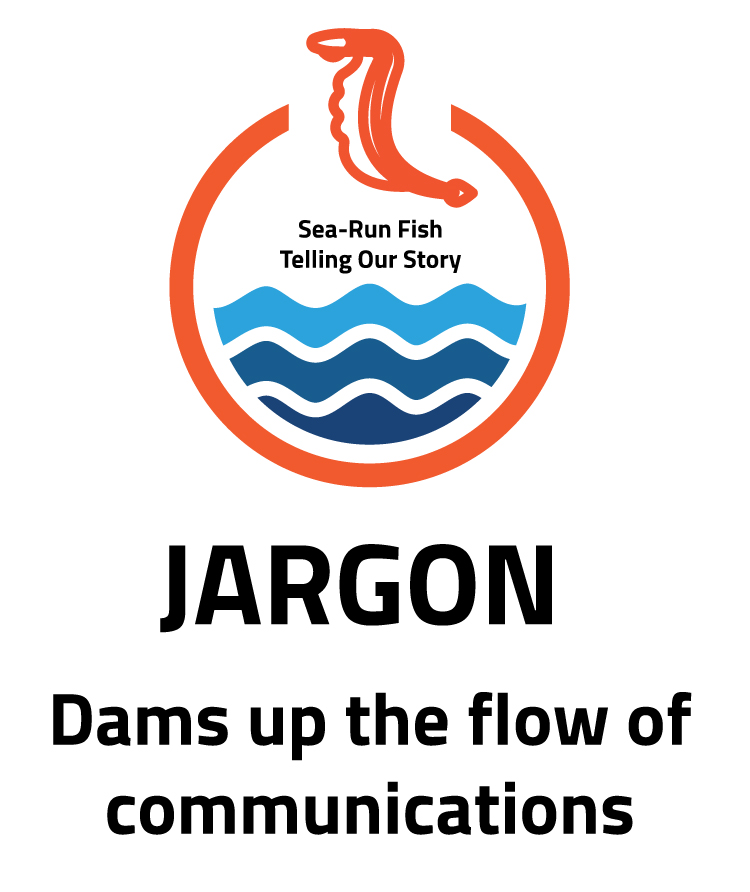
1.5 hours, Summer 2021
Participants from Session 1 were invited to register to work collaboratively in small groups focused on topics generated during the Idea Generation Session held in March 2021. These small groups sought to troubleshoot challenges, develop new ideas for messages, and identify concrete next steps to put outreach options into practice. Small groups also worked to clarify roles and responsibilities among partners working toward shared goals.
Small group topics
Conduct and communicate about scientific studies on issues that affect sea-run fish; June 15, 2021
This small group focused on the need for scientific research and communicating findings to scientific and non-scientific audiences. Research topics encompassed water quality, fish contamination, and safe human consumption levels.
Support the removal of dams; June 29, 2021
This small group focused on topics surrounding barrier and dam removal. This included discussions on supporting dam removal and providing and creating resources to educate the public about issues around dams and dam removal. The group identified a theme of connecting people to the health of the rivers that they know and love through a checklist that helps determine whether that river is connected and healthy for people and sea-run fish.
| Is Your Maine River Healthy? | |
|
|
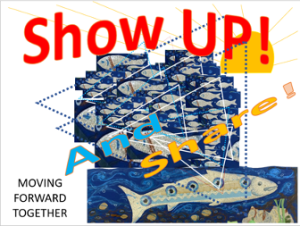
Advocate for sovereignty and sustenance fishing rights of Wabanaki Nations; July 13, 2021
This small group focused on Wabanaki Nations’ cultural connection to sea-run fish and their sustenance fishing rights reserved in the 1980 Settlement Act. The group discussed how it can be difficult to start a discussion about the often underrepresented, yet critical cultural connection between sea-run fish and Wabanaki peoples. To address this difficulty the group suggested creating safe spaces to ‘show up and share’. These inclusive events could bring together Wabanaki and non-Wabanaki people of all ages to share in food, fun, and stories about our past, present, and future relationships with sea-run fish.
Promote the return of sea-run fish and river connectivity; July 27, 2021
This small group focused on communicating the importance of improved river connectivity in the restoration of sea-run fish. The group acknowledged that decisions around the installation of “fish friendly” culverts or bridges typically fall to town officials and private landowners, meaning that informing town residents about the benefits of these actions is critical. The group identified barriers to river connectivity projects as financial costs, design/engineering skills, and capacity/time. Discussion focused on ways to overcome these barriers which included making information more accessible and making more personal connections to the value of the project. When local groups are engaged in an authentic manner, and their needs and challenges are heard, they are more likely to support connectivity solutions.
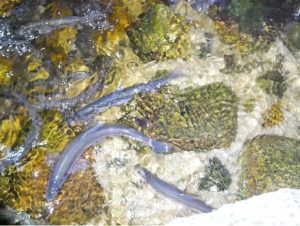
Celebrate and share positive, accurate stories about sea-run fish & healthy rivers; August 10, 2021
This session focused on the importance of communicating the benefits of sea-run fish and healthy rivers through storytelling and celebratory events around these fish returns. A central theme of the discussion was providing immersive experiences in nature where people can connect with rivers and fish through field trips, hosted events, migration viewings, and more. With this focus all ages of people can help create and share positive, success stories of sea-run fish through a variety of formats including the arts.
Session 3: Full group wrap-up to share outcomes
1.5 hours, August 24, 2021
The workshop series concluded with a group wrap-up event where representatives from each working session presented their communication materials, engaged in discussion, and received feedback from the group.
-
-
- Share communication materials
- Discuss suggestions and ideas for moving the work of Telling Our Story forward collectively.
-
Session Outcomes:
-
-
- The workshop series successfully brought together a wide range of partners, organizations, and affiliations across Maine, and has been one of the most cross-cutting sea-run fish initiatives representing a diverse set of perspectives, interests, and goals.
- Participants were engaged and dedicated to achieving positive change internally and externally.
- Shared draft products and received feedback from Brooke Tully
-
Workshop series survey
As a collaborative effort aimed at starting a conversation and connecting a community of practitioners, the inclusion of a pre- and post-workshop series survey was essential to gather baseline data from participants and evaluate the process and outcomes of this workshop series. The results reveal current patterns and trends and highlight areas that may benefit from continued collaborative efforts.
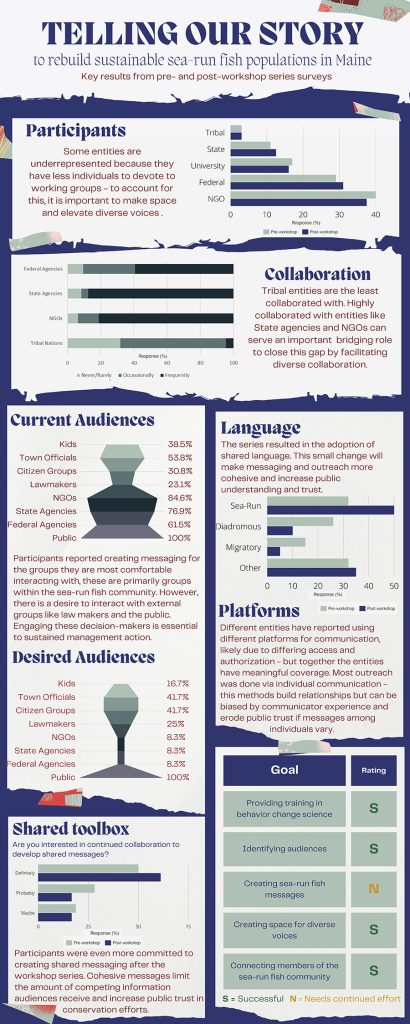
Participants
A double bar graph showing the proportion of participants in the pre- and post-workshop series from each of the participating entity types. The top bar of the graph represents the percent of participants from each entity type represented in the pre-workshop survey and the bottom bar represents the percent of participants from each entity type represented in the post-workshop survey. The x-axis is percent of responses from 0 to 40 and the y-axis is participating entities which include tribal entities, state agencies, university affiliates, federal agencies, and non-governmental organizations. Approximately 3% of the pre- and post-workshop sample is made up of tribal participants. Approximately 11% of the pre-workshop survey and 13% of the post-workshop survey participants are from state agencies. Approximately 16% of the pre-workshop survey and 15% of the post-workshop survey participants are university affiliates. Approximately 29% of the pre-workshop survey and 31% of the post-workshop survey participants are from federal agencies. Approximately 40% of the pre-workshop survey and 38% of the post-workshop survey participants are from non-governmental organizations.
Collaboration
A sideways stacked bar graph representing collaborative frequency. The x-axis is percent of responses from 0 to 100, and the y-axis is participating entities including federal agencies, state agencies, non-governmental organizations, and tribal entities. The stacked bars represent the frequency with which each entity type is collaborated with; Never/rarely, occasionally, or frequently. Approximately 10% of participants never or rarely collaborate with federal agencies, approximately 30% of participants occasionally collaborate with federal agencies, and approximately 60% of participants frequently collaborate with federal agencies. Approximately 10% of participants never or rarely collaborate with state agencies, approximately 4% of participants occasionally collaborate with state agencies, approximately 86% of participants frequently collaborate with state agencies. Approximately 8% of participants never or rarely collaborate with non-governmental organizations, approximately 11% of participants occasionally collaborate with non-governmental organizations, and approximately 81% of participants frequently collaborate with non-governmental organizations. Approximately 32% of participants never or rarely collaborate with tribal nations, approximately 64% of participants occasionally collaborate with tribal nations, and approximately 4% of participants frequently collaborate with tribal nations.
Current Audiences
A funnel graph of the audiences currently targeted with public messaging related to sea-run fish. Participants created the most sea-run fish messaging for the general public, all other outreach efforts are represented as a proportion of what is developed for the general public. Non-governmental organizations received 84.6% as much outreach, state agencies 79.6%, federal agencies received 61.5%, town official 53.8%, kids 38.5%, citizen groups 30.8%, and finally lawmakers received 23.1% of the messaging that the general public received.
Desired Audiences
A funnel graph of the audiences for which participants would like to develop messages related to sea-run fish. The general public was the most desired audience, all other desired audiences are represented as a proportion of the desire associated with the general public. Town officials and citizen groups were both reported to be 41.7% as desired an audience as the general public. lawmakers were 25% as desired of an audience and kids 16.7%, followed by equal interest in reaching non-governmental organizations, state agencies, and federal agencies represented as 8.3% as desired audiences as the general public.
Language
A double bar chart representing changes in language used to refer to fish that spend a portion of their lives in freshwater and a portion of their lives in saltwater between the pre- and post-workshop surveys. The top bar represents responses from the pre-workshop survey and the bottom bar represents responses from the post-workshop survey. The x-axis is percent of responses from 0 to 50. The y-axis is terms used to refer to fish that use both fresh and saltwater including sea-run, diadromous, migratory, and other. Approximately 32% of the pre-workshop survey and 50% of the post-workshop survey participants used the term sea-run. Approximately 26% of the pre-workshop survey and 10% of the post-workshop survey participants used the term diadromous. Approximately 15% of the pre-workshop survey and 5% of the post-workshop survey participants used migratory. Approximately 32% of the pre-workshop survey and 35% of the post-workshop survey participants used the term other than those above.
Shared Toolbox
A double bar chart representing changes in participant interest in continuing to collaborate to develop shared messages between the pre-workshop and post-workshop surveys. The top bar represents responses from the pre-workshop survey and the bottom bar represents responses from the post-workshop survey. The x-axis is percent of participant responses from 0 to 75. The y-axis is level of interest represented as discrete categories, definitely, probably, or maybe. Approximately 50% of the pre-workshop survey and 60% of the post-workshop survey participants responded definitely. Approximately 28% of the pre-workshop survey and 15% of the post-workshop survey participants responded probably. Approximately 18% of the pre-workshop survey and 15% of the post-workshop survey participants responded maybe. No participants in either the pre-or post-workshop survey responded with probably or definitely not.
Goals
A 2-column, 5-row table where the first column is goal and the second is rating. Each row represents a goal of the workshop series and is associated with a rating given by survey participants indicating if workshop series was successful in completing that goal or if the goal needs continued effort to be achieved. Participants rated the workshop series as being successful in achieving each of the following goals: 1. providing training in behavior change science, 2. identifying audiences, 3. Creating space for diverse voices, 4. Connecting members of the sea-run fish community. Participants rated the goal of creating sea-run fish messages as an area that needs continued effort.
